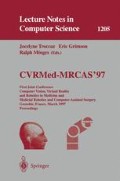Abstract
For many medical applications including computer-assisted surgery, it is necessary to perform scientific computations, such as mechanical deformation, on anatomical structure models. Such patient-based anatomical models are often extracted from volumetric medical images as isosurfaces. In this paper, we introduce a new algorithm for the decimation of isosurfaces based on deformable models. The method emphasizes the creation of mesh of high geometric and topological properties well suited for performing scientific computation. It allows a close control of the distance of the mesh to the isosurface as well a the overall smoothness of the mesh. The isosurface is stored in a data-structure that enables the fast computation of the distance to the isosurface. Finally, our method can handle very large datasets by merging pieces of isosurfaces.
Preview
Unable to display preview. Download preview PDF.
References
M. Bern and D. Eppstein. Mesh generation and optimal triangulation. In D. Du and F. Hwang, editors, Computing in Euclidean Geometry, volume 1, pages 23–90. World Scientific Publishing Co, 1991.
J. Boissonnat and B. Geiger. Three dimensional reconstruction of complex shapes based on the delaunay triangulation. In R. Acharya and D. Goldgof, editors, SPIE Conference on Biomedical Image Processing and Biomedical Visualization volume 1905, San Jose, CA, Feb. 1993.
H. Delingette. Simplex meshes: a general representation for 3d shape reconstruction. Technical Report 2214, INRIA, Mar. 1994.
A. Gourdon. Simplification of irregular surfaces meshes in 3d medical images. In First International Conference on Computer Vision, Virtual Reality and Robotics in Medicine, pages 413–419, Nice, France, Apr. 1995.
A. Gueziec and D. Dean. The wrapper: A surface optimization algorithm that preserves highly curved areas. In Visualisation In Biomedical Computing (VBC'94), volume 2359, pages 631–641, Rochester, USA, Sept. 1994. SPIE.
H. Hoppe, T. DeRose, T. Duchamp, J. McDonald, and W. Stuetzle. Mesh optimization. In Computer Graphics (SIGGRAPH'93), pages 19–25, Anaheim, July 1993.
M. Kass, A. Witkin, and D. Terzopoulos. Snakes: Active contour models. International Journal of Computer Vision, 1:321–331, 1988.
W. Lorensen and H. Cline. Marching cubes: a high resolution 3d surface construction algorithm. ACM Computer Graphics (SIGGRAPH'87), 21:163–169, 1987.
G. Nielson and B. Hamann. The asymptotic decider: Resolving the ambiguityin marching cubes. Visualisation'91, pages 83–91, Oct. 1991.
W. J. Schroeder, J. Zarge, and W. Lorensen. Decimation of triangles meshes. In Computer Graphics (SIGGRAPH'92), volume 26. ACM, Aug. 1992.
R. Shekhar, E. Fayyad, R. Yagel, and J. Cornhill. Octree-based decimation of marching cubes surfaces. In Visualisation'96, San Francisco, Sept. 1996.
R. Shu, Z. Chen, and M. Kankanhalli. Adaptive marching cubes. The Visual Computer, 11:202–217, 1995.
Author information
Authors and Affiliations
Editor information
Rights and permissions
Copyright information
© 1997 Springer-Verlag Berlin Heidelberg
About this paper
Cite this paper
Delingette, H. (1997). Decimation of isosurfaces with deformable models. In: Troccaz, J., Grimson, E., Mösges, R. (eds) CVRMed-MRCAS'97. CVRMed MRCAS 1997 1997. Lecture Notes in Computer Science, vol 1205. Springer, Berlin, Heidelberg. https://doi.org/10.1007/BFb0029227
Download citation
DOI: https://doi.org/10.1007/BFb0029227
Published:
Publisher Name: Springer, Berlin, Heidelberg
Print ISBN: 978-3-540-62734-0
Online ISBN: 978-3-540-68499-2
eBook Packages: Springer Book Archive

